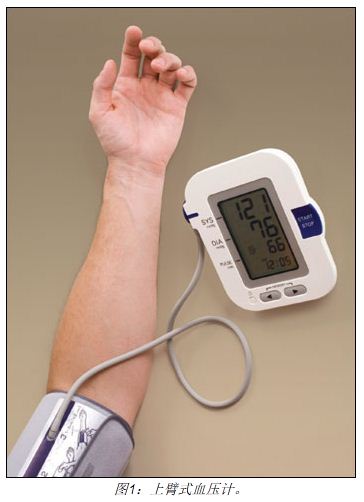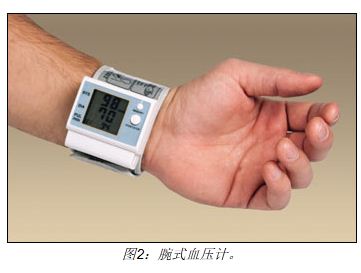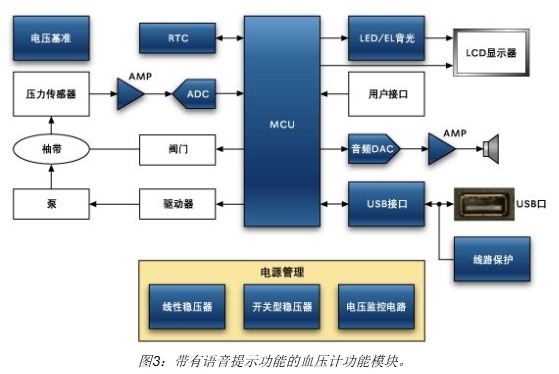With the improvement of people's living standards, medical monitoring equipment has gradually entered the family, and sphygmomanometer is a common medical device for household use. The sphygmomanometer uses a pneumatic cuff and monitoring device to measure blood pressure by listening. It can also measure blood pressure using a pressure sensor. This sphygmomanometer can be achieved in two ways: by manually inflating the cuff, using a stethoscope to monitor the sound of the arterial wall (auscultation), or by embedding a pressure sensor inside the sphygmomanometer to measure the vibration of the arterial wall (vibration) law). This article refers to the address: http:// There are two types of automatic blood pressure monitors: the upper arm sphygmomanometer and the wrist sphygmomanometer. The upper arm sphygmomanometer contains an air bag that is attached to the upper arm during measurement. The inflatable cuff is connected by a leather tube to a monitor placed near the arm. The wrist sphygmomanometer is small in size and the entire device can be wrapped around the wrist. Therefore, these products are more stringent in size. Some upper-arm sphygmomanometers require manual inflation, but most of the upper-arm and wrist sphygmomanometers on the market today are fully automated. Measurement technique: The automatic electronic sphygmomanometer first inflates the cuff to provide sufficient pressure to prevent blood flow in the local aorta. As the pressure is gradually released, the measured pressure value is the systolic blood pressure when blood begins to flow through the artery. The rate of pulse beat can also be monitored. Continue to slowly deflate, so that the pressure inside the cuff is gradually reduced. When the cuff pressure is reduced to be equal to or slightly lower than the diastolic pressure, the blood flow is restored. The measured value is equivalent to the diastolic pressure of the heart. This completes a complete measurement cycle, which is done by pumps, pneumatic cuffs, electronic valves and pressure sensors in the unit. The signal generated by the pressure sensor is conditioned by an operational amplifier or instrumentation amplifier and sent to the ADC. Then, for different types of sensors and monitors, the appropriate method is used to calculate systolic, diastolic, and pulse rate in the digital domain, and the resulting The result is displayed on the LCD screen, and the data and corresponding time/date are usually stored in the non-volatile memory. Data interface Some sphygmomanometers can upload data to a computer for more in-depth analysis and post-measurement tracking, and can transfer data over a USB interface. You can choose a discrete USB transceiver or you can choose to have this transceiver microcontroller built in. Voice prompt: The audible indicator of the sphygmomanometer can be a simple beep or a high-end voice prompt. A simple buzzer can be driven by one or two pulse width modulation (PWM) output ports of the microcontroller; for advanced voice prompting functions, an audio digital-to-analog converter and amplifier can be selected to process the audio signal. Power Management: The upper arm sphygmomanometer is usually powered by 4 AAA alkaline batteries, and the wrist sphygmomanometer is mostly powered by 2 AAA alkaline batteries. The sphygmomanometer pump and analog circuit require 5V or 3.3V power supply, and the digital circuit selects 3.3V or 1.8V power supply according to the specific measurement technology. Thus, a typical upper-arm sphygmomanometer requires a single step-up/step-down switching power supply to supply 5V to the pump/analog circuit, and a low-dropout linear regulator (LDO) to power the digital circuit. A typical wrist sphygmomanometer uses a boost converter to provide the 3.3V power required by the pump/analog circuitry, and an LDO that converts the input voltage to 1.8V to power the digital circuitry. In order to extend battery life, the sphygmomanometer can turn off the power while working, and only maintain the real-time clock (RTC) and quickly restore the sphygmomanometer's working state. Display and backlight: Most sphygmomanometers use a simple segment LCD display with 100 or fewer segments, and the LCD driver is usually integrated inside the microcontroller. A backlight is provided using one or two white LEDs or EL lamps. The wrist sphygmomanometer can be powered by a white LED with a switching power supply topology, and the upper arm sphygmomanometer can be powered by a linear regulator. Microcontroller: At the heart of the sphygmomanometer function circuit is a microcontroller. Maxim's MAXQ2010 microcontroller is a low-power, 16-bit device that includes a high-performance 12-bit multiplex ADC and LCD interface. Combined with high-performance, low-power mixed-signal integrated circuits, it can be ideally used in sphygmomanometer design. The device features 64KB of flash memory, 2KB of RAM, three 16-bit timers, and two Universal Synchronous/Asynchronous Receiver/Transmitter (USART). Flash memory facilitates prototyping and mass production, and mask ROM versions are available for cost-intensive, high-volume production. The microcontroller operates from a 2.7V to 3.6V supply. For low power performance, the MAXQ2010 includes a low-power sleep mode that selectively shuts down peripherals and has multiple power-saving modes. Electrostatic Discharge: All sphygmomanometer monitors must pass the Electrostatic Discharge (ESD) test requirements of IEC 61000-4-2, either with built-in ESD-protected devices or with ESD protection wires to protect the lines exposed at the interface locations.
Electric Kettle are made by food grand stainless steel and
Polypropylene. It helps you to have a 1.8L bottle of boiled water in 5 minutes.
Type 201 Stainless stell is the main material for the electric kettle housing.
sometimes called a tea kettle or teakettle, is a type of pot, typically metal,
specialized for boiling water, with a lid, spout, and handle, or a small
kitchen appliance of similar shape that functions in a self-contained manner.
Kettles can be heated either by placing on a stove, or by their own internal
electric heating element in the appliance versions.
Features:
360-degree swivel base: Great way with
cordless pouring; kettle lifts off base for cord. Separate base to move kettle
conveniently, 360°rotation design.The cord can be wrap neatly into the base
bottom for easy storage. The concealed stainless steel heating element brings
fresh hot water with no metal Taste.
Soft Handle for easy using: Comfortable
stay-cool handle; brushed stainless steel finish. Cool-touch buttons and
ergonomic stay-cool handle.
Large Capacity for Multiple Cups: 1.8 L large
capacity, with Max. water level inside the kettle. almost 1.5x the size of most
tea makers. Brew up to 6oz at once! Perfect for small gatherings & parties!
Fully Stainless Steel Faster Boils: Stainless
Steel Interior cover with no plastic taste. Boils water rapidly, save more time
and energy. Faster than the microwave & safer than your traditional
stovetop teapot.
On/off switch with LED light.: Automatic
On/Off switch makes life easier. No need standing by for hot water. It shuts
down when reaches a full rolling boil. Boil-dry and overheat protection to
ensure the safety use.
Time Saver & Higher Safety: 1500 watts
energy efficient for quick heat-up time brings water to a boil, Fast boil, auto
shut off and boil dry protection technology with three-prong plug.
Brushed stainless steel housing
Applications
Making hot water for tea brewing.
Making Coffee.
Cool milk-tea.
Steaming eggs.
Any occation if you need hot water in short time.
Any
color of plastic is available to produce but in big quantity. Its
Electric Kettle Electric Kettle,Stainless Steel Electric Kettle,Electric Boiler,Big Capacity Electric Kettle Guangzhou Taipeng Electrical Appliances Technology CO., LTD. , https://www.taipengelectric.com



January 26, 2020